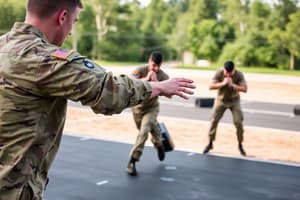Podcast
Questions and Answers
What is the primary purpose of military correspondence?
What is the primary purpose of military correspondence?
- To provide a platform for casual conversations between soldiers.
- To document personal experiences of military life.
- To communicate formally among military personnel, units, departments, and organizations. (correct)
- To entertain readers with stories from the battlefield.
Which of the following is NOT a typical component of military correspondence?
Which of the following is NOT a typical component of military correspondence?
- Sender's details
- Recipient's details
- Subject
- Personal anecdotes (correct)
What is the recommended approach for the length of military correspondence?
What is the recommended approach for the length of military correspondence?
- Correspondence should be as brief and concise as possible, focusing on one topic. (correct)
- Correspondence should be as lengthy as possible to demonstrate the writer's vocabulary.
- Correspondence should be as long as necessary to convey the message.
- Correspondence should be as long as the recipient's attention span allows.
What is the primary purpose of including standardized formats in military correspondence?
What is the primary purpose of including standardized formats in military correspondence?
Which of the following is NOT a common form of military correspondence mentioned in the text?
Which of the following is NOT a common form of military correspondence mentioned in the text?
What is the primary reason for including additional information, such as file numbers or distribution lists, in military correspondence?
What is the primary reason for including additional information, such as file numbers or distribution lists, in military correspondence?
What should be avoided when writing military correspondence?
What should be avoided when writing military correspondence?
How should subject headings be formatted in military correspondence?
How should subject headings be formatted in military correspondence?
What should be followed when specifying font sizes in military correspondence?
What should be followed when specifying font sizes in military correspondence?
Which of the following elements should adhere to established guidelines in military correspondence?
Which of the following elements should adhere to established guidelines in military correspondence?
What should be followed regarding security classification and distribution of military correspondence?
What should be followed regarding security classification and distribution of military correspondence?
What is the purpose of following established guidelines and standards in military correspondence?
What is the purpose of following established guidelines and standards in military correspondence?
Flashcards are hidden until you start studying
Study Notes
Military Correspondence
Military correspondence refers to the formal communication exchanged among military personnel, units, departments, and organizations. It covers various forms of written messages, including letters, reports, memos, telegrams, and emails.
While there isn't a single standard format for military correspondence, there are guidelines and recommendations to ensure clarity, brevity, and precision. Here are some key aspects of military correspondence:
Structure and Content
Military correspondence typically includes the sender's details, recipient's details, subject, and content. Some documents may require additional information like file numbers or distribution lists.
- Sender's Details: Provide the name, rank, and contact information of the sender.
- Recipient's Details: Indicate the recipient's name, rank, and contact information.
- Subject: State the purpose of the correspondence in one sentence.
- Content: Write the main body of the letter, report, or memo, detailing the issues or matters discussed.
- Additional Information: Depending on the nature of the correspondence, you may need to include file numbers, security classifications, or distribution lists.
Standards and Formatting
Military correspondence should follow specific standards for formatting and content. These include:
- Format: Use standardized formats like message forms or standard templates to ensure consistency.
- Length: Keep letters concise and focused on one topic.
- Language: Write clearly and avoid military jargon unless addressing fellow soldiers or officers.
- Subject Headings: Use uppercase letters and underline the last line of the subject heading if there are two or more lines.
- Page Numbering: Follow a specific page numbering format.
- Font Points and Pixels: Specify the font size in points or pixels.
- Punctuation, Capitalization, Spelling, Hyphens, Separating Words, Margins: Adhere to established guidelines for these elements to maintain uniformity.
Security Classification and Distribution
Military correspondence may contain sensitive information that requires security classification markings and restricted distribution. Be sure to follow procedures outlined in relevant standards and regulations regarding this matter.
In summary, military correspondence plays a crucial role in maintaining effective communication within military organizations. By following established guidelines and standards, you can ensure your messages are clear, efficient, and respectful of the confidential nature of military information.
Studying That Suits You
Use AI to generate personalized quizzes and flashcards to suit your learning preferences.




